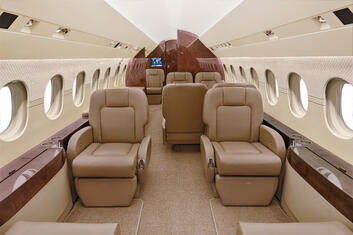A refurbishment can completely transform and revive an aircraft, but those dramatic interior updates also come with a significant downtime and a price tag. Almost every aspect of an aircraft interior can be handcrafted, right down to the stitching on the seats, making each experience unique.
Although unique projects don’t necessarily lend well to generic FAQs, a general pattern of questions do emerge from prospects looking to have their aircraft refurbished, and following are a selection of the most commonly asked that are received by the team at Duncan Aviation... As the answers will demonstrate, it’s all in the planning.
 How much is my aircraft refurbishment going to cost?
How much is my aircraft refurbishment going to cost?
When customers call about a potential refurbishment, they want to know how much it’s going to cost. That’s an understandable question. Setting a realistic expectation is important, and if the initial question were that simple to answer, we’d plaster price stickers on our products and services. As mentioned, many refurbishment projects tend to be customized though.
Although there are several steps that can be selected to modify and transform your aircraft paint or interior until it is ‘top-of-the-line’, it is also possible to stick to a smaller refurbishment budget and retain some, or most of the original interior. It’s important to establish exactly what you are trying to achieve through a refurbishment project, which will help establish how much you really want to spend.
“We do a lot of investigative questioning to determine what the customer really needs and wants,” says Completions Sales Representative Matthew Schepers. “Once we determine that, we can begin with a ballpark budget and work out all the details so the price we quote is the price you pay.”
What kind of downtime am I looking at?
“The earlier we can talk to a customer and finalize a plan, the shorter the downtime,” offered Completions Sales Representative Nate Klenke. “It’s really that simple.”
In essence, as much planning prior to an aircraft’s arrival needs to be made as possible, allowing the actual refurb process to become as efficient as possible, thus helping reduce the downtime. As an example, some customized carpets might take up to 16 weeks to arrive, so they need to be ordered well in advance of the aircraft’s arrival at the shop. Likewise, selection of seat patterns, shell panels and cabinets well in advance of the airplane’s arrival will all help cut weeks off the downtime.
How can I increase capacity and make my aircraft’s cabin more efficient?
Just about every reconfiguration customers ask for is possible. Accordingly, Duncan Aviation has an on-site engineering team and can approve a Supplemental Type Certificate (STC) through in-house Organization Delegated Authority (ODA).
As an example, when a Falcon 900 customer needed more storage, space was found by swapping the rarely-used forward lavatory for a closet and auxiliary gallery storage cabinet. The lines from the toilet were capped and a cabinet built and inserted that molded around the old chute just in case a future owner should wish to reinstate the lavatory.
The customer was able to use the aircraft in a way that best met his needs, but the value of having a second lavatory was not erased as it could easily be restored. Several other customers followed suit after the initial STC was obtained.
Planning ahead
If possible, from a timing and budget perspective, it is recommended that you schedule interior and electronics modifications alongside a major inspection to get the most out of the time an aircraft spends in the shop. But as always, plan well in advance of that event as to exactly what you need, thereby eliminating unnecessary downtime and expense during the actual refurbishment project.


